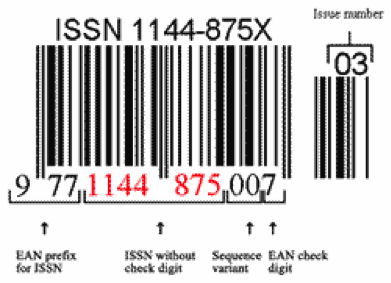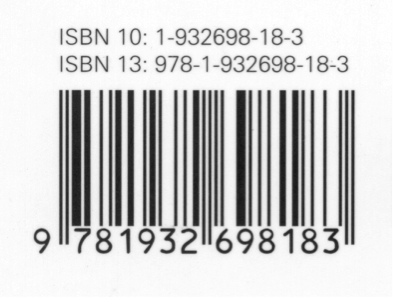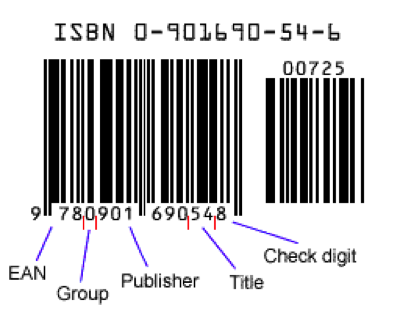Barcodes Guide for Magazine Publishers
Bar Codes Are No Longer Optional on Magazines
Sorry to say that to talk about Bar Codes one has to introduce various acronyms. There is a glossary for these at the bottom of this page [see below].
If you want to know how to adjust your barcode when you change your cover price see the end of this page.
With more and more retailers using EPOS systems and EDI bar codes are no longer optional. We would prefer that the Bar Code appears on the cover. For magazines this is the first thirteen digits of the European Bar Code number.
If you do not have an ISSN [International Standard Serial Number] you will need to get one before you can create bar codes. Contact the ISSN Application UK Agency The British Library https://www.bl.uk/collection-metadata/application-for-an-issn , https://www.bl.uk/about-us/terms-and-conditions/assignment-of-issn or go to ISSN UK Centre - http://www.bl.uk/bibliographic/issn.html#obtain.
If you are not using any Bar Codes on your magazine but you have an ISSN you should be able to calculate bar codes see below.
If you are using US Bar Codes on your magazine we would like you to put a European type Bar Code on the copies you send to Central Books. With your ISSN you should be able to calculate bar codes see below. If the bar code begins 977 you are probably using a European type magazine/ISSN bar code.
Some magazine publishers choose to ignore the ISSN root to an EAN and instead use ISBN's. If you assign a separate ISBN [International Standard Book Number] to each issue of your magazine you should use the ISBN 13 to create your bar code see below. You will need a different ISBN for each issue. If you are only using the old ISBN 10 you can calculate the ISBN 13 and generate your bar code number. If the bar code begins 978 or 979 you are probably using a European book/ISBN type bar code.
What to do next
If you are using ISBN's continue as you are, making sure you print the ISBN 13 bar code and you allocate a new ISBN to each issue. If your issues have unique ISBN's please always use the ISBN to create the bar code. Do not use other types of bar code when you are allocationing ISBN's to each issue. Do not use the same ISBN for more than one issue. Do make the best use of your ISBN and register each issue via Nielsen Book Editor https://www.nielsentitleeditor.com/titleeditor/.
If you are already using a 13 digit EAN / Bar Code number continue as you are.
If you are not printing a bar code or you have been using the UPC system start using the 13 digit EAN / Bar Code number as soon as possible. You would do well to take a look at http://www.ppa.co.uk/resources/Retail/ the PPA is the Periodical Publishers Association and its retail pages include a downloadable PDF file on bar codes.
If you are not sure about ISBN versus ISSN bar code (example ISBN 978 1932698183 and example ISSN barcode 977 114872007) then you might use this rule of thumb. If your magazine is annual (or comes out less than once a year) we would recommned aquiring a number of ISBN's from your ISBN Agency and giving each issue its own ISBN. If your magazine comes out between 2 and 4 times a year the choice is marginal, it you think book selling internet sites will want to buy your magazine then the ISBN option is for you. In most cases magazines that come out more the 4 times a year should stick to the EAN version of an ISSN.
If you choose to allocate individual ISBN's to magazines, in effect treating an issue as a book you must get the book registered on Nielsen Book Editor https://www.nielsentitleeditor.com/titleeditor/ . Not doing this defeats the point of having an ISBN that you paid for, this is your way of get the value from the ISBN.
If you choose to use ISBN's DO NOT put the same ISBN on two issues. ISBN's are unique to one issue (or one "book"). If a new issue comes to use with the same ISBN as a previous issue we may have to charge to put a revsied bar code on the new issue.
Design Problems
We do understand that some magazines that we distribute have such high design standards that they do not wish to put the bar code on the cover. In such cases we ask publishers to place the bar code on the inside covers or some very accessible place.
ISSN's, Bar Codes and ISBN's.
Most periodicals have an ISSN [International Standard Serial Number], this is a 8 digit number that is unique to each periodical series, currently ISSN's are not used on the Central Books database. Publishers will find ISSN's are useful when selling subscriptions via agencies like Blackwell or SWETS. We would recommend acquiring an ISSN. For more information visit the relevant pages at the ISSN UK Centre.
|
Bar Codes for Magazines Bar Codes are now essential for selling magazines into some of the large chains. For more information visit the relevant pages at the ISSN UK Centre or the Periodical Publishers Association used to allow more access to non-members. Last time we searched we found https://www.barcodelive.org/magazine-barcode
To Calculate the check digit on your bar code go to http://www.gs1.org/barcodes/support/check_digit_calculator.
|
This is an ISSN Bar Code using the standard EAN 13 format with the issue number tagged on.
|
|
Bar Codes for Books Bar Codes are now essential for selling books to retailers. Some periodical publishers choose to assign ISBN's to issues of their periodicals so the issue can sell through some book channels. For more information visit the relevant pages at the ISBN Agency . To Calculate the check digit on your bar code go to http://www.gs1.org/barcodes/support/check_digit_calculator. |
This is an ISBN Bar Code using the standard EAN 13 format. It also shows both ISBN10 and ISBN13.
This is an ISBN Bar Code using the standard EAN 13 format. It shows the ISBN10 and explains the how the number can be broken down. |
ISBN's are the book version of ISSN's, they were a 10 digit number that is unique to a particular edition of a book now they are 13 digit. Some books are ascribed ISBN's as well as being part of a series and therefore also having an ISSN. There is clearly a blurred zone between magazines and books. If you feel that a particular issue of your magazine should be treated like a book you may want to get an ISBN this will allow bookshops to use electronic ordering systems to order that particular issue and find the book [special issue] on their books in print databases. Assuming you are a Central Books client we would recommend that you contact first to discuss the best way of acquiring an ISBN or lists of ISBN's for future books, alternatively visit the relevant pages at the ISBN Agency. An error we often see is a magazine publisher gets an ISBN for one issue and they use the same ISBN for another . An ISBN is unique for one book or one issue.
Price Changes effect the bar code on your magazine if it begins with 977. You will need to change the last three characters of the bar code each time you change the price. For example if the bar code was 9771234567010 when the price was £5.00 and now it is changing to £6.00 the barcode changes to 9771234567027. The 11th and 12th characters are a price change count or sequence variant. So in the case they changed from 01 to 02 which makes the 13th character (the check digit) also change. If you want to have a one off price (so issue 59 of your magazine was priced at £5.00, issue 60 at £10.00 and the issue 61 back to £5.00) then use 99 as you as as the 11 and 12th characters so in this example 9771234567997. If you have a later one off price you count down so you use 98.
Software.
There are a number of software packages available via the internet, we have used GDS Barcode Freeware [the web links change a lot so click here to search] and Byte Scout Bar code freeware (https://bytescout.com/products/enduser/misc/barcodegenerator.html). One publisher's designer uses www.agamik.co.uk. We recommend you shop around for what is best for your needs.
An alternative is to get to grip with barcode fonts or add-ins to software you already use. We used https://www.barcodesinc.com/free-barcode-font/ to get barcode fonts onto our PC's but to make codes from fonts you need to understand that a scanner will not read 9781913211820 but needs the characters to begin * and end *, so the correct character set displayed in barcode fonts would be *9781913211820*. If you use Adobe's Illustrator you can add-ins like EAN13 MAKER.
Glossary
|
EAN |
European Article Number |
|
|
EPOS |
Electronic Point Of Sale |
|
|
EDI |
Electronic Data Interchange |
|
|
ISBN |
International Standard Book Number |
|
|
ISBN 10 |
Old style ISBN being replaced by 13 digit ISBN's from 2007 onwards. |
|
|
ISBN 13 |
||
|
ISSN |
International Standard Serial Number |
How a Change of Cover Price Effects your Barcodes
This section is only relevant if you use standard magazine EAN barcodes. If you use the North American magazine barcodes or ISBN 13 book standard barcodes you should ignore this section.
If your barcodes begin 977 this page tells you what to do when you change your retail price.

Your magazine's barcode will look something like the bar code pictured to above. This bar code has 13 digits followed by 2 digits denoting the issue number. If the publisher were to change the price characters 11 and 12 would clock up by 1. This in turn changes the check digit, character 13.
To work out what your barcode will look like after changing the price:
- Take the first 10 characters [these will remain the same and are 977 1144875 in the example above]
- Look at characters 11 and 12 and increase them by 1. If they are currently 00 they become 01 or if they are 15 they become 16. [In the example above they change from 00 to 01]
- Now add the new 11 and 12 characters to the other 10. [After a price the above barcode's first 12 characters become 977114487501]
- Go to http://www.gs1.org/barcodes/support/check_digit_calculator. and in the EAN/UCC-13 box enter the new set of your first 12 characters. Press enter and you will be told the new check digit. [In the example the new check digit is 4]
- Add this check digit and you now know 13 digit part of your barcode and this shows retailer that the price has changed. [In the example the new 13 digit part of the barcode becomes 9771144875014]
To summarise for the above example the current issue bar code is 977 1144875 00 7 - 03. If issue 4 is going to change its price the barcode will be 977 1144875 01 4 - 04.
One Off Price Change
If you want to have a one off price (so issue 59 of your magazine was priced at £5.00, issue 60 at £10.00 and the issue 61 back to £5.00) then use 99 as you as as the 11 and 12th characters so in this example 9771144875 99 1. If you have a later one off price you count down so you use 98.
Assuming you are a Central Books client and you are still unsure about how your barcode should change when you change your price please get in touch with us.
You can search our knowledge base for more articles about book and magazine distribution at https://www.centralbooks.com/knowledge-base.html

